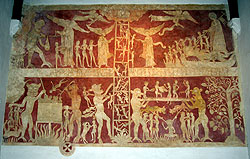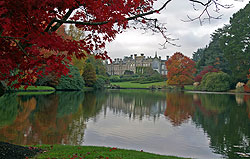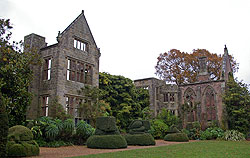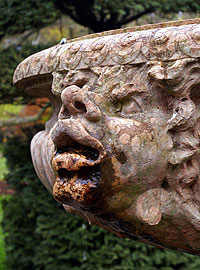Frank's travels around Britain 2008.
Autumn colours.
I travelled down into and through lowering clouds until, by the M25, it was so dark we
all had our lights on ... not a lot of chance of getting some decent pictures I
thought .. but I wasn't thinking about the luck of the travel Gods!

The previous month, I was just too early to see the trees changing into their autumn colours. I could see trees by the motorways were going russet & gold but without the joy of winter sunshine adds to photographs, it all looked flat & somewhat dull.
On
Tuesday morning it was no better. I was travelling through the damp mists, just looking for somewhere
interesting that was
out of the rain. I got that in spades when I found the ancient church
of St. Peters & St. Pauls
in Chaldon, just off the A23, as I headed south. Inside is the most amazing
mural! It was painted, experts believe, between 1170 - 1200 by an unknown monk.
In the history of European culture, this period is considered part of the High
Middle Ages the era of Richard I (8
September 1157 – 6 April 1199)
 King
of England from 6 July 1189 until his death. This was Richard the Lionheart, or
Coeur de Lion, who fought in the Third Crusade against Saladin! We are talking
about only 100 years after 1066. The King spoke very little English!
King
of England from 6 July 1189 until his death. This was Richard the Lionheart, or
Coeur de Lion, who fought in the Third Crusade against Saladin! We are talking
about only 100 years after 1066. The King spoke very little English!
Incredibly, this magnificent treasure was whitewashed over & re-discovered in 1860 by the Rector Rev. Henry Shepherd. This is very similar to what happened to the wall paintings in the church at Copford. According to experts, with the Reformation came the widespread destruction of murals, sculptures and stained glass in churches. This was expressly ordered by King Edward VI in 1547 and again by Queen Elizabeth I in 1559. Even the few artworks that survived these orders were destroyed by Puritans or Cromwell's army in the 1600s. The obliteration of murals involved first washing the walls, then covering them with a coat of whitewash (made of white lime mixed with water). Fortunately this treatment did not completely destroy the paintings, and in many cases the whitewash has been removed to reveal at least a faded version of the precious artworks.
At Chaldon, the painting
is a depiction of the ladder between heaven & hell, shown in wonderful detail. The
restoration was under taken by Mr. J. G. Weller in connection to the Surry
Archaeological society. It remains in amazingly good condition today. I have provided a link to an expert's
description of the story it is telling. In the history of all wall paintings, the site states clearly,
"Comparisons of this remarkable painting are impossible. It is unique in the
fullest sense of that much-abused word, and there is simply nothing else, in
England, or as far as I know, elsewhere, to compare it with". It's full
title appears to be "The Purgatorial Ladder, or Ladder of Souls, with the Seven
Deadly Sins".
 I
was left with the prospect of trying to take pictures to show how the awful weather
was on this trip. After a visit off the main road to Old Oxted, a
pretty village in Surrey (it seems to be separated from the main town of Oxted)
I climbed a hill to see what views I could get that would show all the mist &
crappy weather! When I was looking round I saw the sun breaking through the
clouds in the south. Although I hadn't yet been before, I knew that Sheffield
Park Gardens was south of there and that it had one of the best arboretums anywhere. Tom Tom took me right to it!
I
was left with the prospect of trying to take pictures to show how the awful weather
was on this trip. After a visit off the main road to Old Oxted, a
pretty village in Surrey (it seems to be separated from the main town of Oxted)
I climbed a hill to see what views I could get that would show all the mist &
crappy weather! When I was looking round I saw the sun breaking through the
clouds in the south. Although I hadn't yet been before, I knew that Sheffield
Park Gardens was south of there and that it had one of the best arboretums anywhere. Tom Tom took me right to it!
Sheffield
Park was one of the gardens designed by Capability Brown. It shows that once again, the
wealthy have passed on to the nation, a treasure. I am not sure that the ri ch &
famous ever
envisaged the common man being free to walk on their grounds but nevertheless,
various influential families had the foresight to plant for the future. The
contrast between the first few years after making the decision to plant a major
garden and the results we see, shows what foresight these people had. By today's
standards, they had unlimited funds, huge acres of land & the will to see their
later generations benefit from their first ideas. It
is the most stunning autumn display I have ever seen. The variety, the colours &
the wonderful reflections to be seen in the four lakes is breathtaking. The
gardens were first laid out in the 18th century by it's owner Arthur G. Soames. The
original site's history goes back
to the time of the doomsday book.
ch &
famous ever
envisaged the common man being free to walk on their grounds but nevertheless,
various influential families had the foresight to plant for the future. The
contrast between the first few years after making the decision to plant a major
garden and the results we see, shows what foresight these people had. By today's
standards, they had unlimited funds, huge acres of land & the will to see their
later generations benefit from their first ideas. It
is the most stunning autumn display I have ever seen. The variety, the colours &
the wonderful reflections to be seen in the four lakes is breathtaking. The
gardens were first laid out in the 18th century by it's owner Arthur G. Soames. The
original site's history goes back
to the time of the doomsday book.
The sun had really enhanced the photographs and made that visit worth while. In contrast, the next day was back to the weather being miserable as I tried to pull of the same trick with Nymans, another house with a great garden. The lack of sun just dulled even the nicest view.
 The Messel
family have lived at Nymans, from the late 1800's. By the 1930's, the garden had
reached its peak and was regularly opened to the public, but all this came to an
end with the Second World War. Fuel for the hot-houses disappeared and the staff
shrank from 11 to three elderly men. A further disaster struck in February 1947
when fire destroyed most of the house. The
gardens, however, survived. Subsequently the surviving rooms were still used
occasionally, to entertain friends and as a base from which to run the garden.
Following Col. Messel's death in 1953, Nymans became one of the first gardens to
be transferred to the National Trust.
Today the ruined house still provides a
romantic background for the garden and the remaining Messel Family rooms are
open to the public but not in the winter months.
The Messel
family have lived at Nymans, from the late 1800's. By the 1930's, the garden had
reached its peak and was regularly opened to the public, but all this came to an
end with the Second World War. Fuel for the hot-houses disappeared and the staff
shrank from 11 to three elderly men. A further disaster struck in February 1947
when fire destroyed most of the house. The
gardens, however, survived. Subsequently the surviving rooms were still used
occasionally, to entertain friends and as a base from which to run the garden.
Following Col. Messel's death in 1953, Nymans became one of the first gardens to
be transferred to the National Trust.
Today the ruined house still provides a
romantic background for the garden and the remaining Messel Family rooms are
open to the public but not in the winter months.

The one thing I was delighted to see on display at Nymans, was a full sized layout crediting the gardeners who put in all the work. It is remarkable that since Nymans Garden was created in 1890 it has seen only three Head Gardeners: James Comber from 1895-1953; Cecil Nice, who began working at Nymans in 1924 and succeeded James Comber as Head Gardener in 1953; and currently David Masters, who took over when Cecil retired in 1980. This seems different, it's always the families & their famous connections that are seen on any display panels. Seldom are the workers given the same prominence.
The sights I saw in the first week of November are on a separate page. I think they deserve their own space.
Links for
information on this page:
